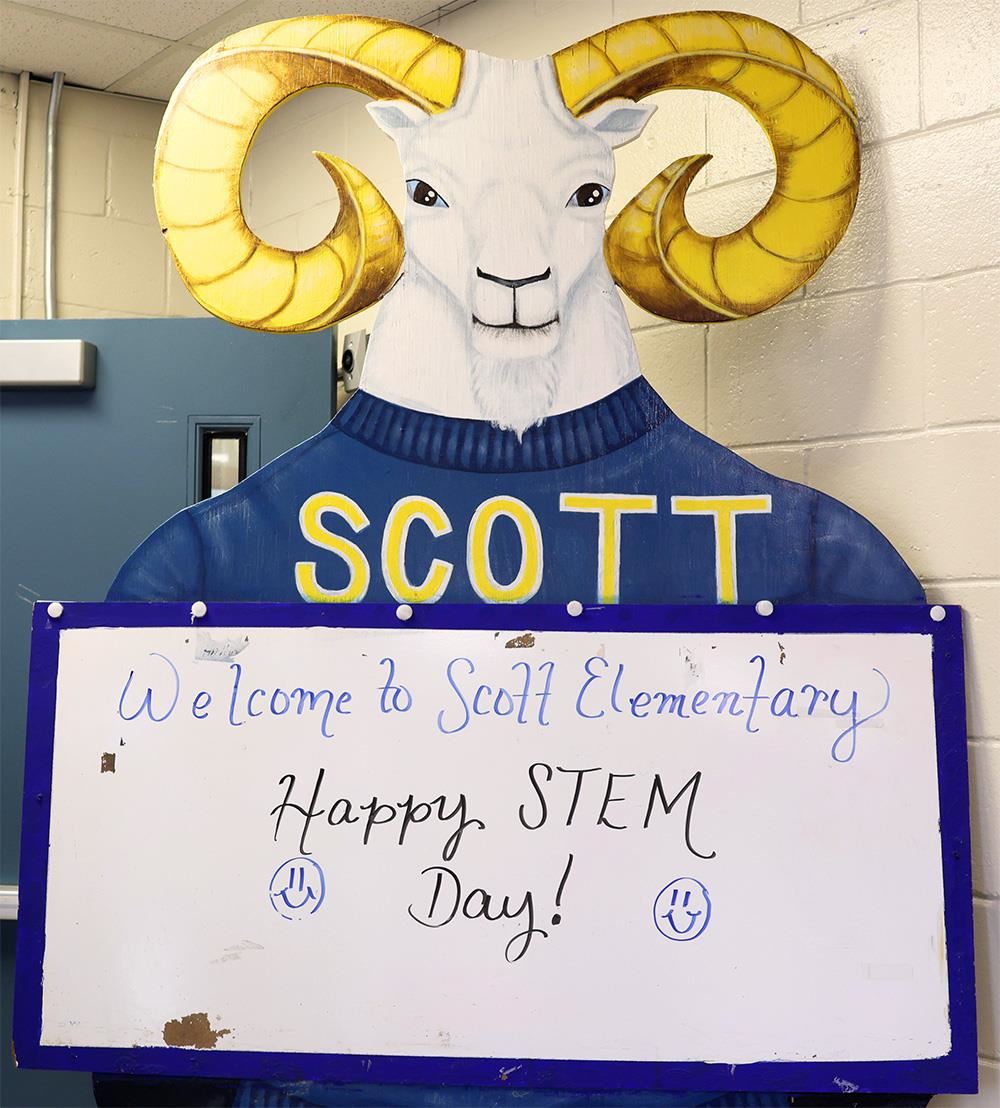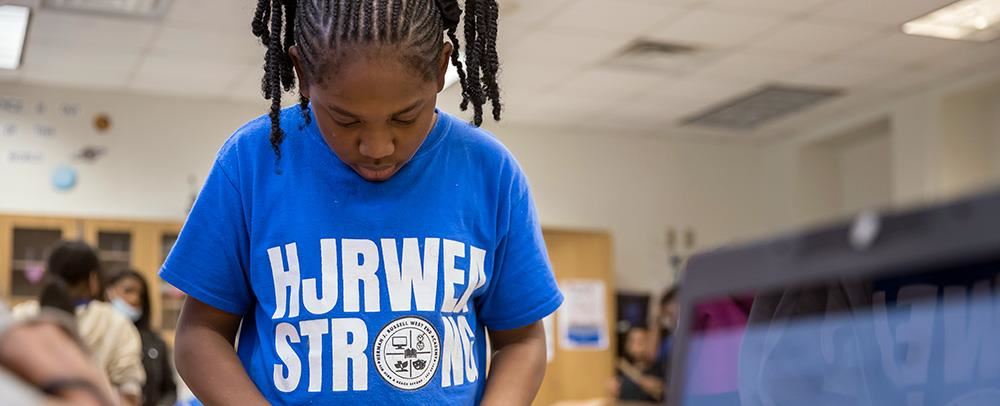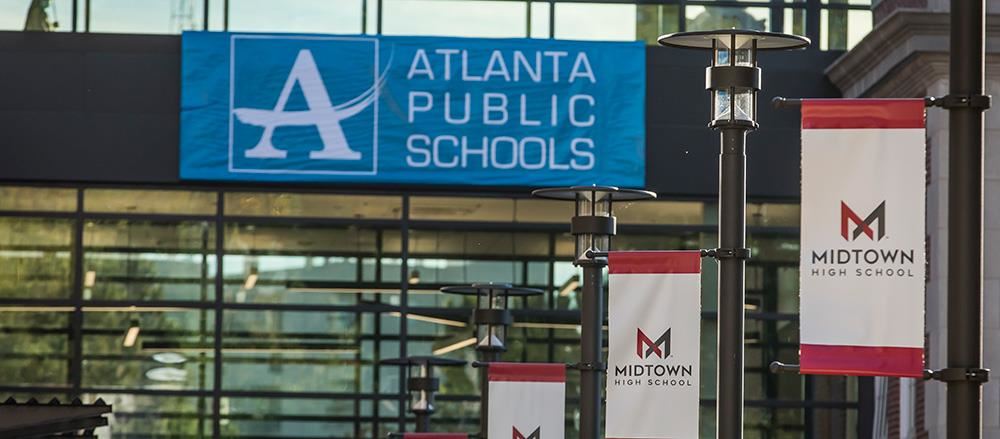- Atlanta Public Schools
- Promising Practices
-
Promising Practices

-
The "Promising Practices" section showcases exemplary schools within Atlanta Public Schools that have demonstrated exceptional performance across various critical metrics, including discipline management, student attendance, academic achievement, talent retention, and subgroup performance, offering valuable insights and replicable strategies for district-wide improvement.
Highlights
-
Howard Middle School
- Exceeded improvement targets for closing gaps in English Language Arts (ELA), Social Studies, and Science
- One of the middle schools with the most students taking courses for high school credit
Strategies:
- Vertical team meetings reviewing student data and associated strategies to help students meet targets
- Co-teaching
- Small-group instruction
- Counselors recommend students for high school courses based on data and giving students choice to select courses that interest them
Quote:
“We are asking questions like, “What do you wonder? What do you notice about the data specifically? What may have caused the changes from one grade level to another? One subgroup to another? Why isn't a subgroup moving? What initiatives are we implementing in the school that are maybe not productive or effective, that we may need to stop and shift our focus?”
Principal Tekeshia Hollis
Research:
Foundational research indicates that reviewing and leveraging student data for instructional decision-making can support student learning and achievement.
A meta-analysis of 26 studies in the Educational Research Review on the impact of co-teaching revealed a medium positive combined effect of .47 for co-teaching on the academic achievement of students.
According to Hattie’s Visible Learning, a synthesis of over 800 meta-analyses, small-group instruction showed a mean effect size of 0.49, indicating a moderate effect size on student learning. Notably, conditions that can enhanced this effect include prior group work experience, cooperative learning strategies, and small group size.
A recent study in American Economic Review finds that effective school counselors have positive impacts on high school graduation and postsecondary attendance rates, suggesting that investing in school counselors is an effective strategy for improving post-secondary enrollment.

-
Bolton Academy
- Highest percent of elementary students exhibiting high growth on Student Growth Percentile in ELA and Math
- CCRPI Progress score of 100 for English Language Learners
Strategies:
- Awareness and accountability for student needs, school vision, standards
- Building staff capacity (including retention, Professional Learning Communities (PLCs), staff collaboration, and staff appreciation initiatives)
- Positive school culture (including promoting inclusion for students)
Quote:
“It's the collaboration between English Language Learner (ELL) support, our coaches who are trained in ELL practices, the General Ed teacher working with ELL support, learning about best practices, and then it's also a culture piece... making sure that we do have inclusive activities and events and we've even met with our Hispanic students about them being language leaders because their Spanish language is a beautiful language.”
Principal Shavaun Mincey

Research:
Empirical studies find that PLCs support improved educator collaboration and improvements to teaching and learning. Staff appreciation initiatives are associated with improved educator productivity, engagement, and retention.
Recent literature indicates a positive relationship between school climate and student academic outcomes across a range of achievement measures. Research suggests that strong, supportive, and positive school climates are positively associated with improvements in student grades, test scores, absences, and high school graduation rates.
-
Sylvan Hills Middle School

- The middle school with the highest score for closing gaps for Students with Disabilities in ELA (score: 34.42)
Strategies:
- Differentiated instruction, based on MAP and IReady data
- Small group instruction (ability grouping), based on MAP and IReady data
- Explicit vocabulary instruction and graphic organizers
- Professional learning for co-teaching
Quote:
“One of our biggest pushes this past school year and this year as well was differentiated instruction and making sure that we focus heavily on small group instruction and scaffolding instruction, not just for the student with disabilities, but for all students. Because we realize that when we provide that small group time with a teacher, the students have an opportunity to really dive deep into the instruction.”
Principal Larry Guilford
Research:
Research finds positive effects of differentiated instruction on student achievement in reading and math. Differentiating instruction ensures that all students can effectively engage with and learn from the curriculum regardless of their abilities or interests.
Small group instruction facilitates differentiation, independent practice, and time for teachers to provide independent interventions.
Research shows that integrating explicit vocabulary instruction into all content areas, not just reading and ELA-related subjects, enhances students’ ability to acquire vocabulary, especially textbook terms that become progressively difficult as students get older. According to Hattie’s Visible Learning, vocabulary programs showed a mean effect size of 0.97, indicating major improvements in reading comprehension in students who experienced vocabulary instruction.
A study in the Journal of the Teacher Education Division of the Council for Exceptional Children found that professional development experiences in co-teaching were related to teacher outcomes, including confidence, interest, and attitude. Teachers with more frequent professional development experiences demonstrated higher confidence in their co-teaching ability.
-
Coretta Scott King Young Women’s Leadership Academy

- High % change in proportion of Proficient and Above in American Literature (28.3 percentage points) and Algebra (20.1pp)
- 100% graduation rate for economically disadvantaged students
Strategies:
- Guided reading, differentiation, and offering students choice
- Use of songs and games to increase student engagement
- Explicit mathematics instruction and zero period
- Review student data and Professional Learning Communities (PLCs)
- Building strong relationships with students
- Monitor attendance and home visits
- Promote a positive school culture and climate
Quote:
“A game changer for us is having a faculty and staff that embraces and loves the whole child. So although our academic outcomes definitely take a high precedence, we are also working to make sure that the whole child is fed and nourished from the social to the emotional to the psychological needs. We are loving our children through whatever obstacles come their way. So the culture and climate is one that's highly conducive to nurturing growth and development.”
Principal Eulonda Washington
Research:
Research finds positive effects of differentiated instruction on student achievement in reading and math. Differentiating instruction ensures that all students can effectively engage with and learn from the curriculum regardless of their abilities or interests.
The National Mathematics Advisory Panel, established by the U.S. Department of Education, conducted a 26- study meta-analysis on math instruction, ultimately finding that explicit instruction has a positive impact when used for teaching word problems, computation, and less common applications.
Foundational research indicates that reviewing and leveraging student data for instructional decision-making can support student learning and achievement.
Recent literature indicates a positive relationship between school climate and student academic outcomes across a range of achievement measures. Research suggests that strong, supportive, and positive school climates are positively associated with improvements in student grades, test scores, absences, and high school graduation rates.
A research review of 46 studies published by the American Educational Research Association found that strong teacher-student relationships were associated, in both the short- and long-term, with improvements in a variety of areas: higher student academic engagement, attendance, grades, fewer disruptive behaviors and suspensions, and lower school dropout rates.
-
Atlanta Classical Academy
The school with the highest percentage of seamlessly enrolled students into college (84%)
Strategies:
- College advising starts junior year, academic advising starts in Grade 8
- Demystifying the college process through early and frequent communication
- Writing and application support
Quote:
“It's a combination of starting early, being really thorough and helping [students] with their preparation, and also the way that we get to know them and really help them find something that they can be really excited about.”
Principal Aaron Schepps
Research:
A recent study in American Economic Review finds that effective school counselors have positive impacts on high school graduation and postsecondary attendance rates, suggesting that investing in school counselors is an effective strategy for improving post-secondary enrollment.
A report from the U.S. Department of Education’s Institute of Education Sciences recommends, based on supporting evidence, supporting students’ college-going aspirations by encouraging students to explore different careers and postsecondary pathways, and providing hands-on support to assist students in completing steps for college application and entry through communication and knowledge-sharing, college visits, and support with college applications.
-
Scott Elementary School
Greatest average daily attendance improvement from 2023 to 2024 (elementary) (11.86 percentage point increase)

Strategies:
- A care team approach of administrators, social workers, counselors, and other support staff, who meet weekly to monitor attendance data and tackle absenteeism issues and causes
- Student-level strategies:
- Incentive programs and competitions at both the student and class levels
- Share information on attendance and publicly recognize good attendance
- Focus on 10-day, tangible and achievable increments with punch cards
- Parent engagement, home visits, and incentives
- Teachers’ objectives include attendance goals
Quote:
“As a committee, we meet weekly and we discuss whatever challenges that may be occurring for any of our students…it may be a medical issue, there may be some homelessness, all of those types of things. When we bring it to the committee, there's multiple people who can service that [challenge].”
Principal Langston Longley
Research:
Implementing a data collection system for tracking student absences can allow district and school leaders to identify trends, understand root causes, and target and monitor the effectiveness of interventions.
While evidence remains mixed, experts suggest that incentives and rewards can be an effective strategy to support attendance when selected thoughtfully, considering specific attendance issues, incentive type, implementation details, and evaluation. However, rewards and incentives for perfect attendance may be counterproductive and marginalize certain student groups (e.g., students with health conditions).
A review of the literature on attendance and family engagement by the American School Health Association shows that when schools and districts engage and partner with families, students are more likely to attend school and succeed.
-
HJ Russell West End Academy

- One of the largest decreases in suspension rates from last year to this year: Out of School Suspension days decreased approximately 52% from SY22-23 to SY23-24 for students with disabilities. Also decreased the number of suspension days for all students by 26%
Strategies:
- Established an Attendance Committee to monitor trends, identify at-risk students, and develop targeted interventions to address chronic absenteeism and tardiness
- Instituted dedicated support staff (Attendance Clerk, Behavior Specialist, and In-School Suspension Monitor)
- Partnered with Big Brothers Big Sisters to provide mentorship for chronically tardy and at-risk students
- Implemented restorative practices
Quote:
“By combining proactive attendance and behavior strategies with restorative practices and mentorship, we have created a more supportive and inclusive environment for our students. This comprehensive approach has not only decreased suspensions but has also improved overall student engagement and success.”
Principal Tonetta Green
Research:
Attendance teams ensure districts have access to the insights and resources necessary to craft comprehensive and supportive solutions to attendance issues. By regularly reviewing data from multiple sources and meeting to bring diverse perspectives together, attendance teams can form ongoing strategies for addressing attendance issues and mitigating barriers.
A study published in the School Community Journal shows that school-based mentoring programs can support positive social and behavioral outcomes for middle grade and high school students including reduced unexcused absences and discipline referrals, as well as increased social connectedness.
Restorative justice practices are a powerful alternative approach to managing antisocial or violent behaviors and promoting prosocial behaviors that help students develop healthy and lasting relationships and build strong communities. Studies show implementing restorative justice practices can lower disciplinary referrals and suspensions.
-
Therrell High School
- Highest decrease in suspension rates for high schools: decreased overall out-of-school suspension days by 48% (suspension rate fell by 1.4 percentage points) from SY22-23 to SY23-24, largest decrease in the district
Strategies:
- Restorative practices (including leadership and staff training on RP)
- *Additionally, a change in policy prohibiting suspending students for level 1 infractions reduced the number of overall suspensions.
Quote:
“It's very easy just to suspend people - restorative practice takes more work and time, and so I am appreciative of the entire admin team to kind of shift [to restorative practices] for the betterment of the students.”
Principal Dante Edwards
Research:
Restorative justice practices are a powerful alternative approach to managing antisocial or violent behaviors and promoting prosocial behaviors that help students develop healthy and lasting relationships and build strong communities. Studies show implementing restorative justice practices can lower disciplinary referrals and suspensions.

-
Jackson High School
- 100% staff vacancies filled
- 80% or higher first year staff retention rate
Strategies:
- Working with staff to identify upcoming vacancies and then starting hiring for open positions immediately
- Induction support system and mentors for new teachers
- Instructional support (e.g., instructional coaches) for new teachers

Quote:
“We have an induction support system here at Jackson; a of a group of our veteran teachers who support the new teachers so that they have somebody, they have a mentor, they can go to to help them navigate.”
Principal Adam Danser
Research:
Starting hiring for new teachers early has many benefits, including recruiting qualified educators, higher candidate quality, and increased retention.
Research indicates that induction programs support retention for first-year teachers. A study in the Review of Education Research found first-year teachers participating in an induction program were “twice as likely to stay in teaching as those who did not receive early support.”
By engaging teachers in mentorship, districts can better support and retain new teachers. Mentorship is particularly recommended for supporting retention of male teachers and teachers of color.
-
Beecher Hills Elementary School
- Tied for highest average staff scores on the Georgia Health Survey
- For the Spring 2024 Employee Engagement Survey, Beecher Hills Elementary, school had the highest grandmean of any school (4.58 out of 5) (94th percentile of all K-12 schools taking the survey)
Strategies:
- Understand and tailor approach based on staff work languages for appreciation
- Care for the staff and ensure they are happy, provide flexibility when needed
- Creates opportunities for staff feedback, involvement in decision-making processes, and buy-in for changes
- Uses Knoster Model of Change to ensure readiness for change and successful outcomes
Quote:
“Giving people grace and understanding that everybody has their own unique challenges and how can I help take some of those obstacles away from you so that you can do your very best here.”
Principal Tiffany Franklin
Research:
The 5 Languages of Appreciation in the Workplace by Dr. Gary Chapman and Dr. Paul White suggests that individualized approaches to appreciation in the workplace (e.g., acts of service, quality time, words of affirmation, tangible gifts, appropriate physical touch) can have positive impacts on employee morale, engagement, and job satisfaction, resulting in improved work performance and reduced rates of turnover.
Engaging and retaining teachers requires districts to allow teachers to feel their voices and opinions have value and are heard. Districts may positively impact teacher engagement by allowing teacher input on decisions that may impact them at the school level.
The Knoster Model, founded by complex change-management expert Dr. Timothy Knoster, indicates that vision, skills, incentives, resources, and action plans are the foundation of successful change within an organization. In the context of districts and schools, the Knoster Model can have similarly effective impacts on supporting system-wide changes, such as the implementation of a Multi-Tiered System of Supports.

-
Midtown High School
Portable Electronic Device (PED) Free Policy (eg. Cell Phones)
PEDs include phones, headphones, earbuds, personal computers, tablets and games.
- Average number of PED confiscations from classrooms has remained steady at an average of three to four per day schoolwide in a school of 1700+ students.
- During the first semester of SY2024-25, 1,100 students had zero PED infractions.
Strategies:
- Every student issued a personal Yondr pouch on the first day of school along with a copy of the new PED-free policy.
- Student phones and earbuds are placed in Yondr pouches and locked by school personnel before students pass through metal detectors each morning.
- Students remain PED-free from 8:30 to 3:30 each day, including lunch and passing periods.
- All students are expected to bring their APS-issued computer each day.
- Teachers who observe a PED during class time text a designated support person who comes to retrieve the device and issue consequences. Parents must come to the school building between 9:00 AM and 3:00 PM to retrieve confiscated devices.
Quote:
“In short, cell phones pose a significant risk to our students’ learning, their mental health, and their safety. Cell phones also present a significant burden on our teaching and non-teaching staff. We polled our teaching staff about the biggest challenges to teaching at Midtown High.”
Principal Betsy Bockman
Research:
Data highlights a significant threat to teen mental health posed by access to smart phones and social media since 2010, including a 60% increase in depression and a 50% increase in suicide attempts among girls.
Recent research suggests cell phone use during class significantly detracts from student learning and academic achievements.
Best practice supports the collection and dissemination of additional data on cell phone use in schools including perception surveys and secondary research to further educators’ understanding of the challenges.
Additional Impact:
- PEDs are virtually non-existent in Midtown classrooms.
- Teachers report higher levels of student engagement and socialization in classrooms.
- Teachers report much-improved job satisfaction.
- Students report increased socialization with peers and more successful completion of schoolwork during school hours.
- During school weeks, Midtown teens are gaining seven hours per day (35 hours per week) of disconnectivity from social media and other potentially harmful digital applications.



